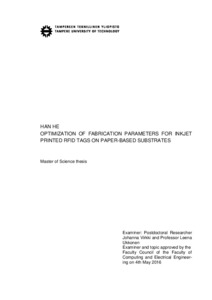Optimization of fabrication parameters for inkjet printed RFID tags on paper-based substrates
He, Han (2016)
He, Han
2016
Master's Degree Programme in Information Technology
Tieto- ja sähkötekniikan tiedekunta - Faculty of Computing and Electrical Engineering
This publication is copyrighted. You may download, display and print it for Your own personal use. Commercial use is prohibited.
Hyväksymispäivämäärä
2016-05-04
Julkaisun pysyvä osoite on
https://urn.fi/URN:NBN:fi:tty-201604213870
https://urn.fi/URN:NBN:fi:tty-201604213870
Tiivistelmä
Inkjet printing is a non-contacting additive depositing method for fabricating electric devices on versatile substrates, which provides a great potential for different Internet of Things (IOT) applications. It enables fast, cost-effective, and environmentally friendly production. Paper-based substrates, like coated paper, uncoated paper, and cardboardare used for printed patterns, and silver nanoparticle ink is applied in this study. Printed layers need to be sintered to form conductive traces, and in this experiment, thermal sintering is selected, since it is easy to operate and has stable performance.
The aim of this thesis is to study the possibility of inkjet printing on paper-based substrates using silver nanoparticle ink and to optimize the printing parameters for fabricating passive ultra-high frequency (UHF) radio frequency identification (RFID) tags on these substrates. A simple line pattern with dimension of 5mm × 30 mm was first printed on these substrates to evaluate the conductivity, and surface magnified images from the optical microscope were taken to analyze the performance.
The silver nanoparticle ink was successfully sintered with thermal sintering on three paper substrates and four cardboards. For every substrate, specific printing parameters and layers are needed to achieve best conductivity performance. Then, inkjet-printed UHF RFID tags were fabricated on these substrates. According to our measurements, the tags on paper substrates showed peak read ranges of 4 – 6.5 m, and the tags on cardboard substrates exhibited peak read ranges of 1 – 6 m. Based on these results, the performance of these inkjet-printed UHF RFID tags is sufficient for many IOT devices and potential applications.
The aim of this thesis is to study the possibility of inkjet printing on paper-based substrates using silver nanoparticle ink and to optimize the printing parameters for fabricating passive ultra-high frequency (UHF) radio frequency identification (RFID) tags on these substrates. A simple line pattern with dimension of 5mm × 30 mm was first printed on these substrates to evaluate the conductivity, and surface magnified images from the optical microscope were taken to analyze the performance.
The silver nanoparticle ink was successfully sintered with thermal sintering on three paper substrates and four cardboards. For every substrate, specific printing parameters and layers are needed to achieve best conductivity performance. Then, inkjet-printed UHF RFID tags were fabricated on these substrates. According to our measurements, the tags on paper substrates showed peak read ranges of 4 – 6.5 m, and the tags on cardboard substrates exhibited peak read ranges of 1 – 6 m. Based on these results, the performance of these inkjet-printed UHF RFID tags is sufficient for many IOT devices and potential applications.
